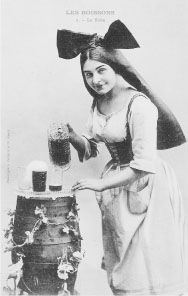France is so famous for its wine and cuisine that few would pause to consider whether the country had an indigenous beer culture of any significance. In fact, beer is consumed and appreciated throughout France. The northern regions that border the beer-centric nations of Belgium and Germany are, not surprisingly, the most steeped in beer culture. Specifically, these are the departments of Nord-Pas de Calais and Alsace-Lorraine.
Alsace-Lorraine is home to some of France’s largest breweries and produces much of the total volume of beer in the nation. Kronenbourg, Fischer Adelshoffen, and Meteor are located in Alsace-Lorraine. On the surface, Alsace can appear every bit as German as it does French, a consequence of the area having repeatedly traded hands between the two nations over the past few centuries. Predictably, beers produced here are primarily derivatives of German pilsner and Munich lager styles. There are some examples of original French styles made in the region, notably versions of bière de mars, alternatively known as “biere de printemps” (spring beer), and in fewer cases, bière de noel (Christmas beer). Although these seasonal Alsatian beers are widely available, they are not particularly distinctive in character, generally possessing a somewhat insipid “industrial” flavor profile.

Postcard from Lorraine, France, c. 1910. pike microbrewery museum, seattle, wa
The region most associated with French brewing tradition is Nord-Pas de Calais. It was here that the modern resurgence of French specialty brewing began in the 1970s and 1980s. Although the majority of the producers here are small by any standard, Nord-Pas de Calais is home to the most breweries and produces a more diverse array of specialty brews than any other French department. Perhaps most telling, Nord-Pas de Calais can claim the highest per capita beer consumption in the nation.
Historically, French people have preferred low-alcohol beers with malty accents. Lower alcohol beers were the norm in the days when people could not depend on safe municipal water supplies as they can in modern times. The past popularity of low- alcohol bière de garde and “bock beers” (the French definition is antithetic to the classic, strong German bock beers) in France is historically evident. Their popularity was usurped with the advent of industrialized brewing and the extraordinary appeal of pale lager beers. In the recent resurgence of specialty brewing it stands to reason that bière de garde, considered France’s primary contribution to world-class brewing, is a “malt forward” brew, albeit reinvented with a higher alcohol content.
In preindustrial France beer was brewed to serve a local population, which was also the case throughout the “grain belt” of Europe and North America. As the French economy became industrialized, small rural breweries suffered and urban breweries grew with the shift in population. With that change, diversity and regional styles declined as well. In northern France, coal mining was once the primary industry, the large workforce associated with that industry supported many small breweries. Coal mining in northern France has greatly declined from its heyday because much of the coal needs are now imported. The waning rural population meant the end of many small breweries in the beer-loving north. Although this change may not have been unique to France, what is notable is that the French countryside suffered acute devastation in the two world wars, especially World War I. In both conflicts, occupying armies routinely stripped brewing equipment for munitions production. Many small breweries never recovered from such severe insult. This sequence of events resulted in the virtual disappearance of regional styles and a French beer market dominated by German-style industrial lagers.
A renaissance in French specialty brewing began in the late 1970s and continues today. In recent years, small breweries have sprung up throughout France, as they have throughout the United States and the Continent. The Les 3 Brasseurs pub brewery chain is particularly widespread, with installations throughout France (plus a few in Canada). A number of small rural breweries have opened expressly to serve a local population. This is a throwback to “the way things once were,” a posture the French regard with considerable affection. Although most of these small breweries may not produce overly distinctive brews, they are instrumental in exposing the French people to the many color and flavor possibilities of specialty beer in a market otherwise dominated by typical mainstream lager styles.
The French brewing industry continues to evolve with the specialty segment showing measured growth as a result of increasing market awareness and acceptance. Typical lagers produced by Kronenbourg and Fischer-Adelshoffen, not to mention Heineken and Stella Artois, each of whom have operations in France, continue to dominate the French beer market as they do the rest of Europe. French consumers may require more time to fully embrace their native specialty beers and develop the same level of Gallic pride in their beer as they have with other justly celebrated French consumables. Imported cheese and wine are often dismissed in France, but imported beers from Belgium and Germany are easily found throughout the country. Perhaps one day the terms “bière de garde” and “bière de mars” will occupy a similar space as “Camembert” and “Burgundy” in French hearts and minds.
Les Amis de la Bière. http://www.amis-biere.org/ (accessed March 22, 2011).
